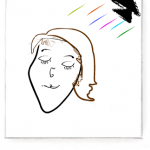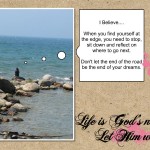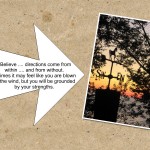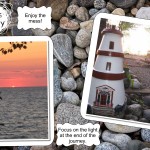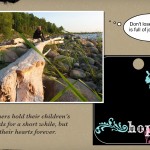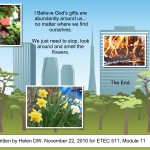Teilhard de Chardin wrote
“You are not a human being in search of a spiritual experience.
You are a spiritual being immersed in a human experience.”
It is with this in mind that I write my reflection for this week’s culminating task. This week, as part of our culminating activity we have been asked to “reflect on the big ideas you gathered from this unit as well as ETEC 511.” It was suggested that we “might reflect on just how this course and its rich discussions will affect your teaching practice.”
The ‘big ideas’ that I have been working with at school come from my personal mission statement, the school’s mission statement, the work done by the teachers as they work with students, and the board’s faith values. These big ideas include the notions of spirituality, nurturing, community, inspiration, belief, and being rooted in tradition. Images that have been woven into my work include the vine, a tree, water drops, rocks (shaped into an inuksuk) and a dove.
As I write this reflection, I look back over the course modules and find threads of each of these big ideas in the online community we have become. I see the interwoven vine of ideas of ethics, sociology, philosophy, politics, history, economics, ecology, and spirituality. Each module we branched through a tree of dialogue as we challenged, disagreed or extended ideas and concepts relating to the foundations of educational technology.
As I look back through the modules, I can see the crafted path that was created for us to walk down together. Each module brought us deeper but was linked to the previous modules. At the end, we have come back, full circle and ‘come to know this place for the first time’
We shall not cease from exploration
And the end of all our exploring
Will be to arrive where we started
And know the place for the first time. T.S. Elliott
Ryunosuke Satoro wrote “Individually we are one drop, together we are an ocean.” This takes on new meaning for me in the context of networked individuals becoming an ocean of change in educational technology.
I have always thought the statement by Sister Joan Cronin “your budget is your mission statement ” was a powerful one for a school principal to remember. I looked at it within a new context during the module on the economics of educational technology.
Heidegger’s writing will continue to challenge my thinking not only personally, but in the way technology is integrated into my work with teachers and learners. I will be vigilant to not allow the technology to enslave me or let it deny the essence of the individual students from being formed in a natural, real environment.
Zhao and Frank’s analogy of ‘invasive species’ resonated with me since I have lived through and worked through many challenges with educational technology and come to many of the same conclusions they presented in their article. The notion of mentoring within education is becoming more prevalent and necessary with quickly changing technologies.
McLuhan (1967) has always rocked my thinking and did so again when I reread this article for the first time during module 6. The medium is the message? No. I think the message I craft as a response to questions, thoughts and challenges is the medium through which I shape my thinking and my thinking is shaped by the messages and thinking of others.
Turkle introduced me to the notion of how technology changes us. Dall’Alba and Barnacle changed the way I look at ’embodied knowing’ and alternate identities. My joy at becoming queen for a day was short lived.
The image of the dove has often been linked with the spirit. It is fitting that it is the last module for our discourse since it will leave the spirit of educational technology as the lasting memory of this course. My human experience with technology (among other things) will help shape my spiritual being.
Throughout all the modules, my thinking was shaped, formed and consolidated through the nurturing and inspirations of other course participants. At times I thought I would drown in the waves of messages. Other times I couldn’t wait to read what had been posted and respond to what others had written.
The question that remains for me is what have I become through this dialogue. As the T. S. Elliott poem reminds me, now that I have explored, what do I know for the first time? What are the foundational truths about educational technology that I know for the first time? That is something I will continue to reflect on in the coming weeks as this course draws to it’s natural conclusion.

